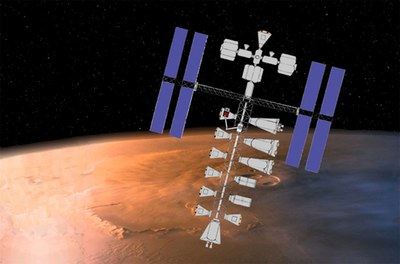
The concept of the waystation could be extended from cislunar
space to Mars or elsewhere in the solar system, as needed.
(credit: J. Strickland)
Cislunar transportation: the space trucking system
by John K. Strickland
Monday, January 21, 2013
All along our interstate and other major roads, we have truck stops designed to service and refuel large trucks. The space equivalent we really need is the waystation.
Many people wonder what all the fuss is all about when they keep hearing the phrase “cislunar architecture.” Many of us are using the phrase to refer to what is essentially a space trucking system, with the equivalent of truck stops and cargo loading yards (freight terminals). Lets use the trucking analogy to explain what we are talking about.
You do not use an expensive truck to carry a load just a single time, and then immediately send the truck to the junkyard to be scrapped. Trucking businesses could not operate this way. Some truck cab and trailer combinations today are probably worth close to a quarter million dollars new. Some cabs alone are close to $100,000 used. Most of the current rockets used today cost over $100 million, so large rockets can be up to 1,000 times more valuable than a tractor-trailer, yet all of them smash into the ocean or desert and become scrap metal after just one flight.
For rockets that take off from the ground, one obvious way to allow re-use is for them to land on the ground intact. SpaceX and some other companies are trying to do just that. Quite a few rockets have now accomplished short flights and landed again safely. Without wings, the landings must be vertical. Re-use with a vertical landing was first done by the DC-X at White Sands on September 11, 1993.
For rocket vehicles in space, the problem is different. We do not want to bring the vehicle back to the ground to refuel, since it is extremely costly to get it up into space in the first place. Once it is in orbit, we want to be able to re-use that vehicle in space over and over again.
However, there is currently no fuel supply or “space gas station” in space where such a vehicle could refuel. After all, what good is a truck without fuel? What good would the Interstate routes be without gas stations? When we refer generically to space “fuel”, we usually mean two propellants: a real combustible fuel such as hydrogen or kerosene, and an oxidizer like oxygen.
Read more: The Space Review: Cislunar transportation: the space trucking system.


















